The NVIDIA GeForce GTX 1650 Review, Feat. Zotac: Fighting Brute Force With Power Efficiency
by Ryan Smith & Nate Oh on May 3, 2019 10:15 AM ESTPower, Temperature, and Noise
As always, we'll take a look at power, temperature, and noise of the GTX 1650, though the 'mini' design shouldn't hold any surprises.
| GeForce Video Card Average Clockspeeds | |||||
| Game | GTX 1650 | ZOTAC GTX 1650 OC Gaming |
|||
| Boost Clock | 1665MHz | 1695MHz | |||
| Battlefield 1 | 1855MHz | 1880MHz | |||
| Far Cry 5 | 1847MHz | 1886MHz | |||
| Ashes: Escalation | 1826MHz | 1829MHz | |||
| Wolfenstein II | 1860MHz | 1905MHz | |||
| Final Fantasy XV | 1867MHz | 1837MHz | |||
| GTA V | 1886MHz | 1905MHz | |||
| Shadow of War | 1857MHz | 1863MHz | |||
| F1 2018 | 1855MHz | 1875MHz | |||
| Total War: Warhammer II | 1865MHz | 1902MHz | |||
| FurMark | 1629MHz | 1672MHz | |||
Power Consumption
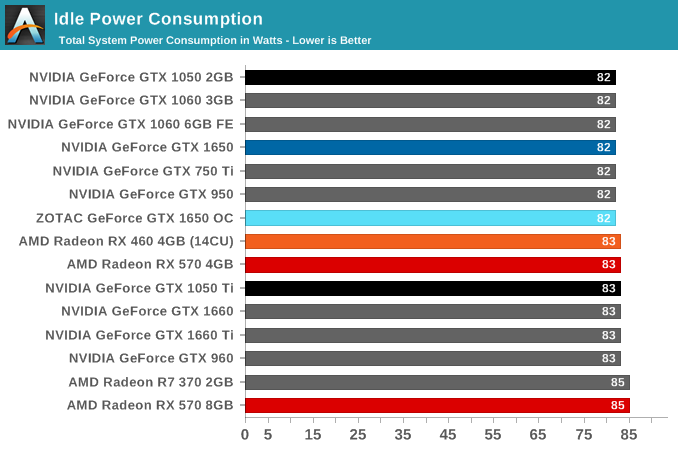
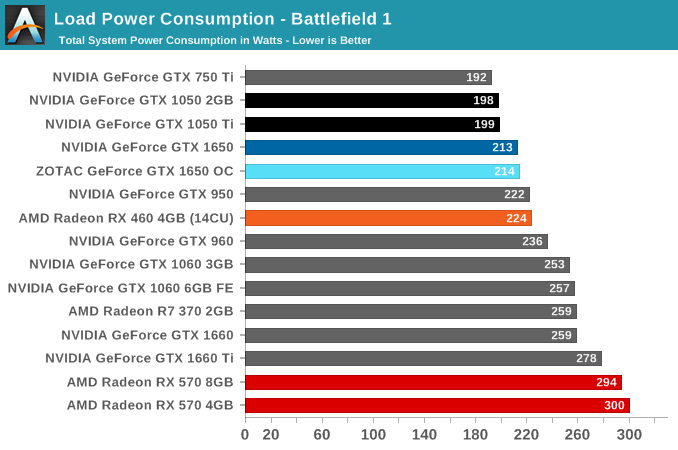
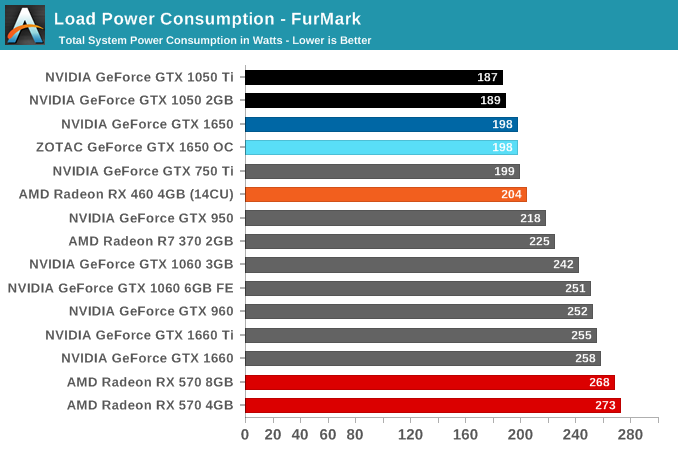
As for idle power consumption, the GTX 1650 falls in line with everything else, with total system power consumption reaching 83W. With contemporary desktop cards, idle power has reached the point where nothing short of low-level testing can expose what these cards are drawing.
Meanwhile at full load, the power consumption disparity between the RX 570 and GTX 1650 is one of the key factors in a direct comparison. Better – but not always – performance can be had for an additional ~75W at the wall, which maps well to the 150W TBP of the RX 570 over the 75W slot-power-only GTX 1650. Though the greater cooling requirements for a higher power card does means forgoing the small form factor.
Temperature
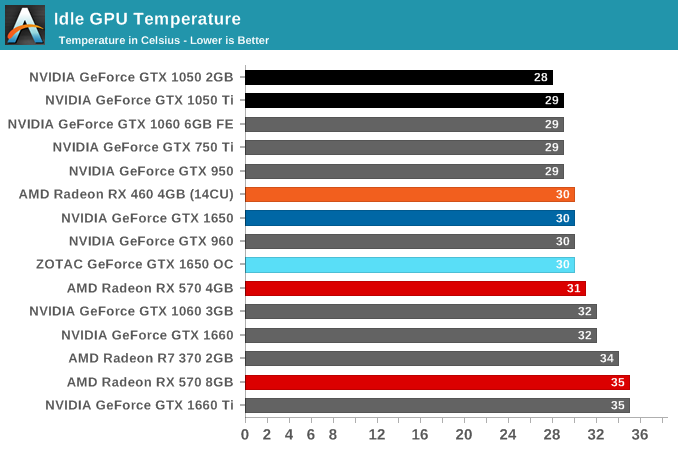
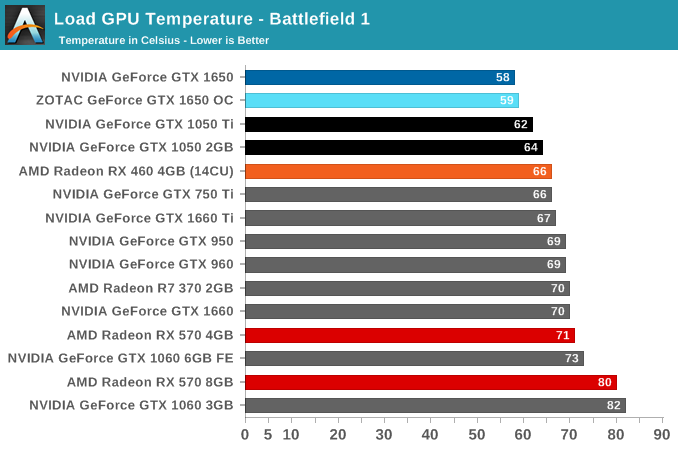
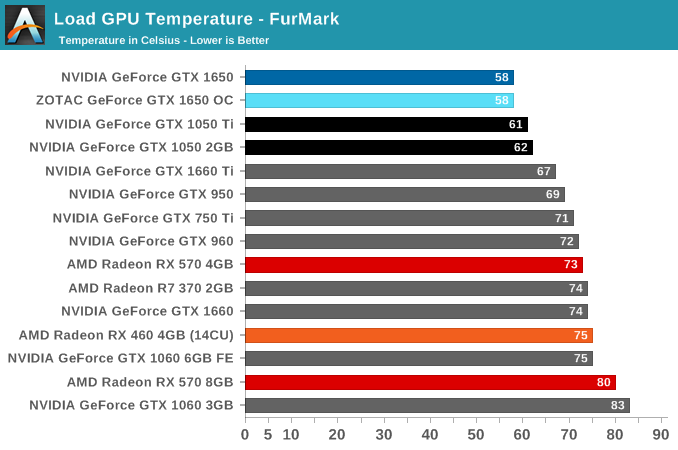
Temperatures all appear fairly normal, as the GTX 1650 stays very cool under load.
Noise
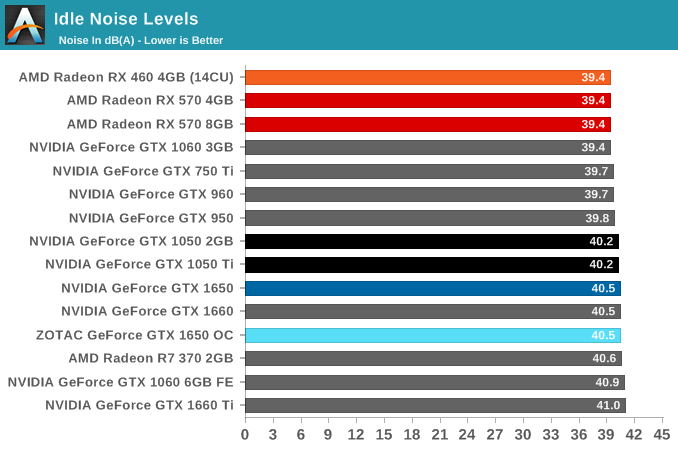
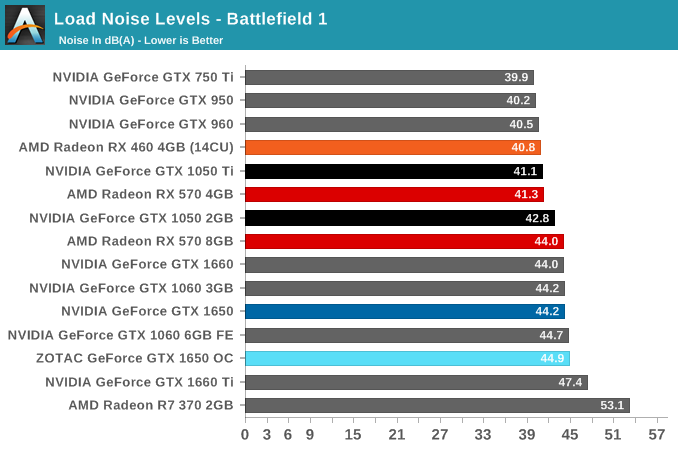
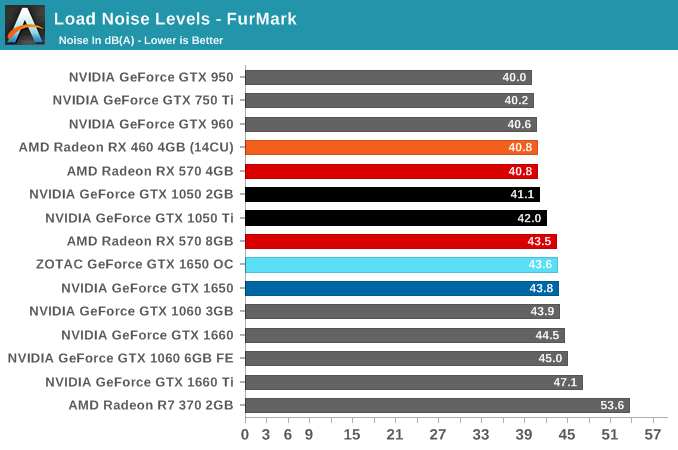
While the GTX 1650 may have good power and temperature characteristics, the noise is not as clean, if only because entry-level cards don't come with 0db fan idling technology, and SFF cards often have to deal with small shrill fans at relatively high RPM. The GTX 1650's fan isn't the worst, but it's not a standout best either. If anything, it looks to be the result of preferring cooling over acoustics, given the very low load temperatures.










126 Comments
View All Comments
Marlin1975 - Friday, May 3, 2019 - link
Not a bad card, but it is a bad price.drexnx - Friday, May 3, 2019 - link
yep, but if you look at the die size, you can see that they're kinda stuck - huge generational die size increase vs GP107, and even RX570/580 are only 232mm2 compared to 200mm2.I can see how AMD can happily sell 570s for the same price since that design has been long paid for vs. Turing and the MFG costs shouldn't be much higher
Karmena - Tuesday, May 7, 2019 - link
Check the prices of RX570, they cost 120$ on newegg. And you can get one under 150$tarqsharq - Tuesday, May 7, 2019 - link
And the RX570's come with The Division 2 and World War Z right now.You can get the ASrock version with 8GB VRAM for only $139!
0ldman79 - Sunday, May 19, 2019 - link
Problem is on an OEM box you'll have to upgrade the PSU as well.Dealing with normies for customers, the good ones will understand, but most of them wouldn't have bought a crappy OEM box in the first place. Most normies will buy the 1650 alone.
AMD needs 570ish performance without the need for auxiliary power.
Yojimbo - Friday, May 3, 2019 - link
Depending on the amount of gaming done, it probably saves over 50 dollars in electricity costs over a 2 year period compared to the RX 570. Of course the 570 is a bit faster on average.JoeyJoJo123 - Friday, May 3, 2019 - link
Nobody in their right mind that's specifically on the market for an aftermarket GPU (a buying decision that comes about BECAUSE they're dissatisfied with the current framerate or performance of their existing, or lack of, a GPU) is making their primary purchasing decision on power savings alone. In other words, people aren't saying "Man, my ForkNight performance is good, but my power bills are too high! In order to remedy the exorbitant cost of my power bill, I'm going to go out and purchase a $150 GPU (which is more than 1 month of my power bill alone), even if it offers the same performance of my current GPU, just to save money on my power bill!"Someone might make that their primary purchasing decision for a power supply, because outside of being able to supply a given wattage for the system, the only thing that matters is its efficiency, and yes, over the long term higher efficiency PSUs are better built, last longer, and provide a justifiable hidden cost savings.
Lower power for the same performance at a similar enough price can be a tie-breaker between two competing options, but that's not the case here for the 1650. It has essentially outpriced itself from competing viably in the lower budget GPU market.
Yojimbo - Friday, May 3, 2019 - link
I don't know what you consider being in a right mind is, but anyone making a cost sensitive buying decision that is not considering total cost of ownership is not making his decision correctly. The electricity is not free unless one has some special arrangement. It will be paid for and it will reduce one's wealth and ability to make other purchases.logamaniac - Friday, May 3, 2019 - link
So I assume you measure the efficiency of the AC unit in your car and how it relates to your gas mileage over duration of ownership as well? since you're so worried about every calculation in making that buying decision?serpretetsky - Friday, May 3, 2019 - link
It doesn't really change the argument if he does or does not take into account his AC unit in his car. Electricity is not free. You can ignore the price of electricity if you want, but your decision to ignore it or not does not change the total cost of ownership. (I'm not defending the electricity calculations above, I haven't verified them)